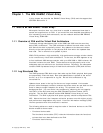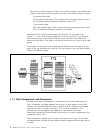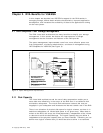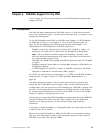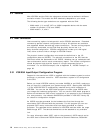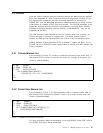2.2.1 RAMAC Virtual Array
The RVA′s virtual disk architecture enables performance improvement in batch
processing. This new architecture, coupled with data compression and
self-tuning capabilities, improves disk capacity utilization. Data from all logical
volumes is written across all the physical disks the array. Automatic load
balancing across the volumes occurs as data is written to the array. Further, the
ability of the RVA to dynamically configure additional volumes of various sizes
eliminates volume contention and thereby reduces I/O bottlenecks.
In the RVA, space that has never been allocated or is allocated but unused takes
up no capacity. Data set size can increase and new files can be created with
minimal need to reorganize existing stored data. Users of traditional storage
systems keep lots of available free space to avoid batch application failures,
wasting valuable space and increasing storage costs. With the RVA it is not
necessary to keep lots of free space to avoid out-of-space conditions.
2.2.2 IXFP/SnapShot for VSE/ESA
Based on the belief that the best I/O is no I/O, IXFP/SnapShot for VSE/ESA
reduces online system outage by reducing the amount of elapsed time backups
and copies need to complete. IXFP/SnapShot for VSE/ESA improves these
aspects of batch processing:
•
Data backup
Data is backed up during batch processing for many different reasons.
Copying data to protect against a hardware, software, or application failure
in the computer center is considered an
operational backup
. The backup
might be a complete copy of all data, or an incremental copy, that is, a
backup of the changes made since the last backup.
Data backups can be taken between processing steps to protect against data
loss if a subsequent job or step fails. These backups are called
interim
backups
. In some data centers, interim backups are done with tapes.
Using SnapShot to replace the backup and/or copy operations speeds up
processing. Tapes are no longer required, and interim backups are done
more quickly. Additional interim backup points are now possible because of
the instantaneous copy capability and reduced batch processing time. The
interim backups are deleted after successful completion of the batch
process.
In many cases the operational backups made are also used for disaster
recovery. Many of the considerations for disaster recovery are also valid for
operational backup. You can minimize the time for disaster backups using
SnapShot, by making a SnapShot copy to disk. You can then restart online
applications before making a tape backup of the SnapShot copy.
•
Data set reorganization
Data set reorganization is very often a time-consuming part of nightly batch
processing. The REORG becomes important especially when it is part of the
critical path of batch processing. Traditional reorganization procedures copy
the affected VSAM key-sequenced data set (KSDS) into a sequential data set
on tape or on another DASD. This activity takes a long time when large data
sets are copied. SnapShot can dramatically reduce the run time when used
in place of IDCAMS REPRO to copy the KSDS into a sequential data set on
another DASD.
Chapter 2. RVA Benefits for VSE/ESA 9



